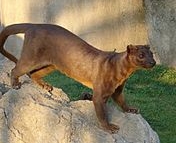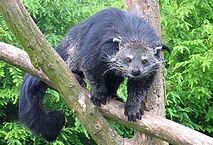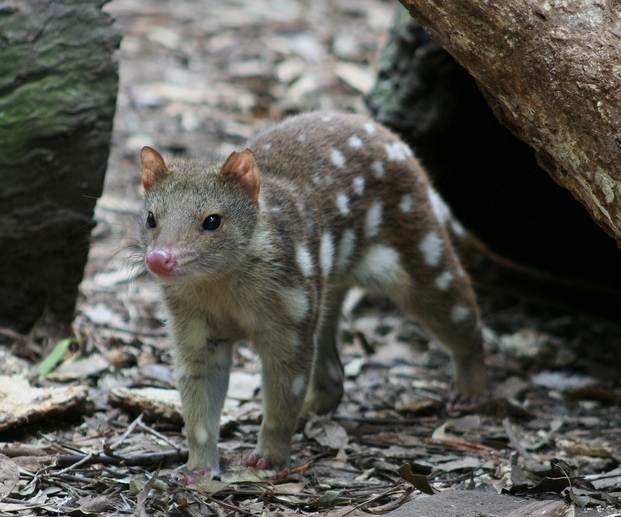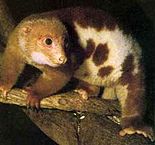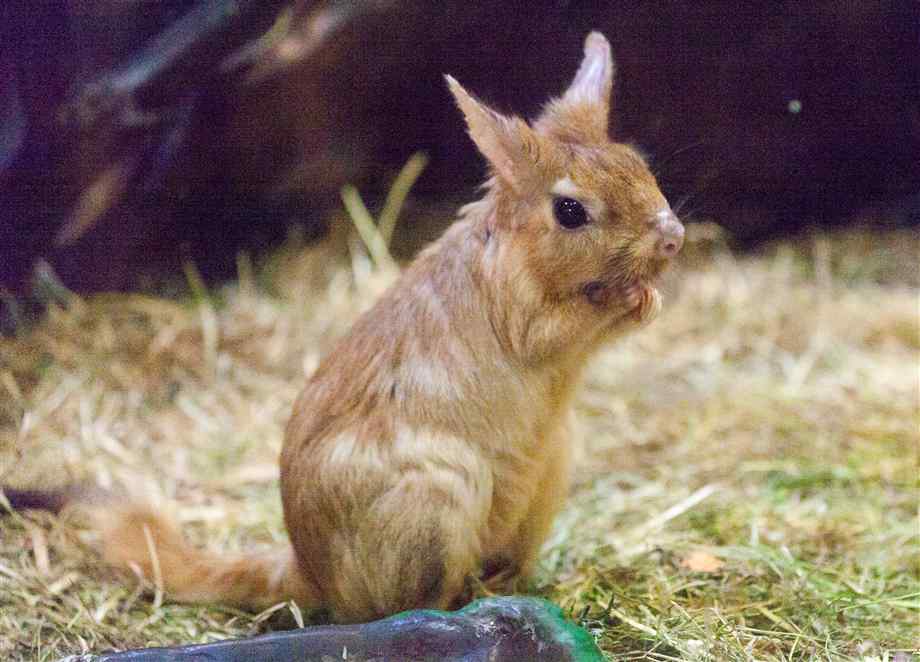Ten Mammals You Have Never Heard Of, Part 2
By Stewart Mittnacht
Last week we encountered the Pyrenean desman, the pichiciego, kinkajou, yapok, and spectral bat. Here are the next five mammals that are great teachers of the Earth’s diversity. Some of these animals' survival is threatened. What are the implications, and how might their potential loss also threaten other parts of their ecosystems?
The animals are pictured from left to right in the following order: fossa, binturong, tiger quoll, cuscus, and springhare. Click on the photo to see a larger image, and read on to learn more about what makes these mammals so fascinating!
Fossa: For nearly 40 million years, Madagascar had no native carnivores apart from crocodilians—the island had broken away from Africa before the diversification of mammals, and its remoteness and the nature of the ocean current system around Africa made colonization from the African mainland difficult. All that changed 20 million years ago, when a small family of mongoose-like animals managed to float to the island, presumably in a hollowed out log that had been washed out to sea in a storm. With no pressure from any cat, hyena, or dog species, the mongoose group was free to diversify and occupy the niches typically taken by larger carnivores, and eventually the fossa evolved from this ancestral line. At roughly a meter in length and possessing the weight of a medium-sized dog, the fossa can be described as a cougar-like animal with a mongoose-like head. Adapted to hunting in trees, it possesses the retractable claws usually found in cats, as well as an articulated ankle joint that can bend backwards—allowing it to move up and down trees with equal speed, a feature shared with squirrels. As the dominant predator on the island of Madagascar, it specializes in taking large lemurs, but has proven, like coyotes in North America and leopards in India, to be able to adapt to a semi-urban environment, replacing its typical prey items with house pets and livestock. This has led to widespread conflict between the fossa and humans, and sadly the animals’ numbers have declined as it becomes the target of persecution. The fossa's continued survival largely depends on the establishment of protected wilderness, but due to the island’s widespread poverty and the weakness of the central government, much of the land has been turned over to exploitation by vanilla plantations and mining interests.
Binturong: Also called the “bear-cat,” the binturong is a viverrid—a group of carnivores that includes civets and genets, both of which possess many of the primitive features present in the miacids, the earliest basal group of the carnivore order. The binturong's bulky body and shaggy hair do tend to resemble that of a bear, but being primarily arboreal, its powerful tail is prehensile. The binturong’s favored habitat is mature forests nearing the end of the succession cycle, commonly known as “tall forest,” consisting largely of slow-growing but large tree species. Since such habitats are tempting targets for the forestry industry in Southeast Asia, the binturong has recently been classified as “vulnerable” by the International Union for Conservation of Nature. An omnivore that specializes in fruit and egg consumption, the binturong is known for being secretive and is rarely the target of predators within its home range. Like many viverrids, the binturong has pronounced scent glands, which it uses to mark its territory high in the trees.
Tiger quoll: At nearly a meter in length, the tiger quoll is the world’s longest carnivorous marsupial. Native to Eastern Australia and Tasmania, the tiger quoll has managed to compete with and outlast the introduction of foxes, cats, and dingoes, whereas other marsupial carnivores, such as the thylacine, were unable to. Part of the tiger quoll’s success is its diverse diet and ability to climb trees, giving it access to shelter and food sources that other native Australian fauna were unable to procure. In some ways, the tiger quoll's lifestyle resembles that of the wolverine: It is at home stalking the forest floor and feasting on carrion, but it is also able to hunt small possums and other arboreal marsupials should the need arise. Ironically, the main threat to the tiger quoll is a new source of “food”—the cane toad. These poisonous amphibians were introduced to Australia by white settlers, and with no native predators, their numbers have exploded. Unfamiliar with the toad’s poisonous skin, many quolls will attempt to make it a meal, only to succumb to the toxins. Fortunately for the quoll, the Australian government has taken great steps to deal with the cane toad problem, and over time the quoll’s future may be secured by this effort.
Cuscus: The cuscus group are possums native to Australasia. Well adapted to an arboreal lifestyle, they possess several features that distinguish them from their North American relative, such as a furred tail and shorter snout, as well as a skull structure that supports large, night-adapted eyes. Slow moving animals, they are sometimes confused with the sloth family, and like the sloth their diet largely consists of a variety of plant materials. Unusually, male cuscus will mark their territory not with urine, but with saliva. Because many species are native to New Guinea, a region that is rapidly being deforested due to the lumber demands of East Asia’s booming construction business, many species have recently been declared extinct in the wild, and the overall future of the group remains bleak.
Springhare: These large rodents resemble a cross between a kangaroo and a hare. South African natives, they are ecologically significant in their region due to their tendency to dig large burrows, many of which are subsequently occupied by other species, including the threatened black-footed cat, after they are abandoned. During the 1980s the springhare suffered from overhunting due to the bushmeat trade, but thanks to economic growth in this part of Africa, reliance on bushmeat has declined significantly, and the springhare is now common once again.
Photo Credits
Fossa: By Ran Kirlian - Own work, GFDL, https://commons.wikimedia.org/w/index.php?curid=4164754
Binturong: By TassiloRau at the German language Wikipedia, CC BY-SA 3.0, https://commons.wikimedia.org/w/index.php?curid=207524
Tiger quoll: By Joshua Cunningham [CC BY 2.0 (http://creativecommons.org/licenses/by/2.0)], via Wikimedia Commons
Cuscus: "Cuscus1" by Shannon Davis <dollbaby78@hotmail.com> - dollbaby78@hotmail.com. Licensed under CC BY-SA 3.0 via Commons - https://commons.wikimedia.org/wiki/File:Cuscus1.jpg#/media/File:Cuscus1.jpg

